The metro station called Kerameikos (despite what the name may suggest) is not the closest stop to the site and museum. The closest is actually the Thiseio stop, but this does not have the escalators to help with arriving and leaving with a pram. Do not make the same mistake I made and expect anyone in the vicinity of the metro station to know how to go to the homonymous archaeological site and museum from the metro. Do not even expect them to know that the stop they are standing in is named after the old cemetery which used to stand in the potter's quarter. That's the sort of mistake that idiots with over-idealized images of their own countries make.
Finally getting oriented with the GPS maps on my swanky Nokia 5800 (which them promptly proceded to die on me) we set off up Pireos towards the entrance of the Kerameikos. At some point in between death-defying maneuvers necessitated by the lack of pavement on some parts of the road, I realized that A. was missing a sock. She had been playing with them, and evidently she'd been playing with the sock formerly on her right foot a little too much. We proceeded barefoot for the rest of the journey. It was a Sunday, early afternoon. The fleasiest part of the flea market is set up just outside the entrance to the site and with it a plethora of 'used' goods, prospective buyers and the sort of people who trade in used goods of uncertain provenance. Great.
Once we found the entrance, behind a stack (literally) of used stereos and speaker systems, the museum and surprisingly the site itself are quite pram-friendly.
The museum is essentially a square building with an atrium-like light well in the centre. Gone are the old-school wooden cases from years ago (that you can still see in museums like Thera and Naxos). Everything is new and shiny, including the patches of damp causing the paint to bubble and crumble in some places.
One side of the square houses the sculpture - two kouroi, a number of sphinxes and some grave stele, together with a boundary marker with interesting epigraphy. There are also some classical family grave markers of the overly classical style which is too much for me. The exhibition passes into the Atrium where the large marble bull memorial draws all the attention and smaller low relief works sit around the edges overshadowed by the bull. From there, we start the history of Athenian pottery…
The first leg covers the sub-mycenaean, protogeometric and geometric eras.
Next we have the first representational ceramics, going through to the mature black and red figure eras.
The final leg of the square has more classical and too much hellenistic pottery. Labelling is in the most rudimentary name rank and serial number style which characterises so many Greek museums, which is a pity as there is a lot of potential to explain aspects of the ancient world in this museum.
Pieces I particularly enjoyed are:

Grave marker - bearded boxer: The piece was found re-incorporated into the Themistoclean walls of Athens as a spolion. It is remarkable for being a quite individualistic portrayal of a presumably recognisable person at a time when portraiture was not really developed.
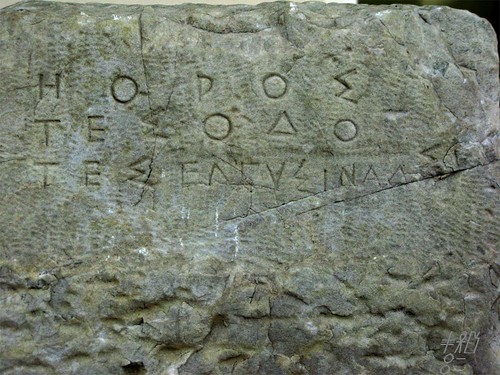
Boundary marker, showing the boundary of the road for Eleusis (a nearby town with a very important sanctuary, the road for which passes through the cemetery of the Kerameikos): ΗΟΡΟΣ ΤΕΣ ΟΔΟ[Υ] ΤΕΣ ΕΛΕΥΣΙΝΑΔΣΙ
It is interesting to see the H being used as a rough breathing on the word Horos, but not on Hodos and also interesting to see the E used where we would expect an H. Guys who dig epigraphy could probably date it on these grounds alone to the nearest five years, but this kinda thing ain't my bag, baby.
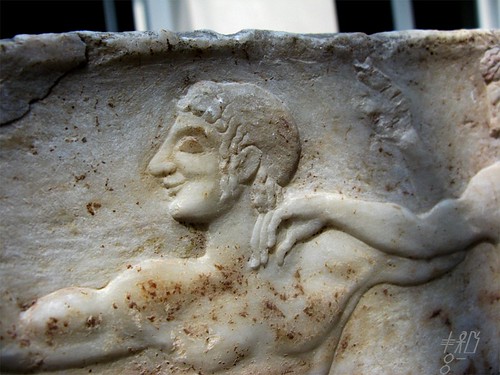
It's archaic. I like it for the hair, for the hands and for the smile, although I did not make a note, so I cannot write too much about this.
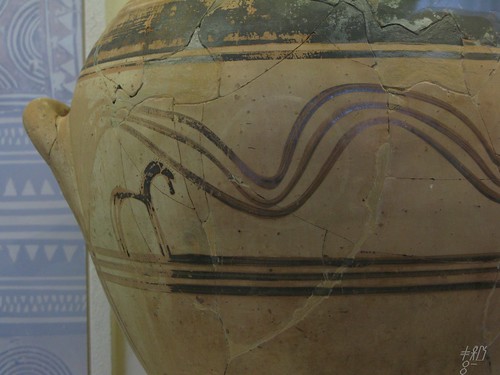
The cinerary urn from tomb 18/I of the Kerameikos cemetery in Athens dates from the 10th century BC and aside from the wavy lines, sports one of the earliest depictions of horses in Attic vase painting.

From a tomb dating between 750 and 700 BC. The depiction of the warrior is pretty standard - helmet plume, beard, twin spears and swords together with a sort of "boeotian" shield. I like this sherd because you can clearly see the individual brushstrokes used to make up the warrior and at the same time you have a nice look into a cross section of the fabric.
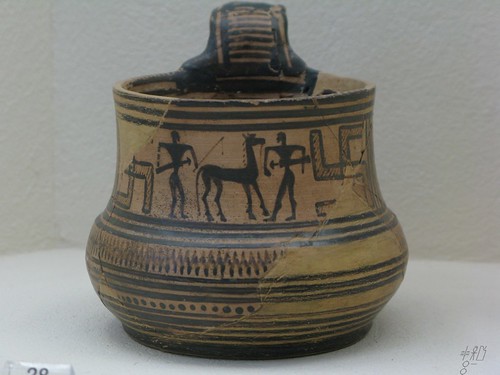
This vase dates from the first quarter of the eighth century BC and depicts two men taming a horse. It is one of the earliest depictions of the human form in Attic vase painting.
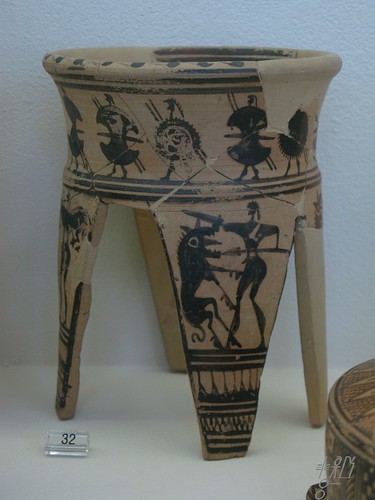
From a tomb dating between 740 and 730 BC. The tripod shape is one associated with ritual use, burnt offerings or funerary meals. The decoration is split into two bands - a frieze along the top showing standard geometric-era warriors and little vignetted warriors wrestling lions in the legs. The depiction of the warrior is pretty standard - helmet plume, beard, twin spears and swords together with a sort of "boeotian" shield, alternating with the standard round shield. The lion in the lower register is depicted as a ferocious beast, but clearly not one with which the artist is familiar.
More pots can be viewed on Flickr here: A visit to the Kerameikos in April 2010
We then went outside with A. for a photograph together in the Kerameikos proper.



























-.jpg)


















